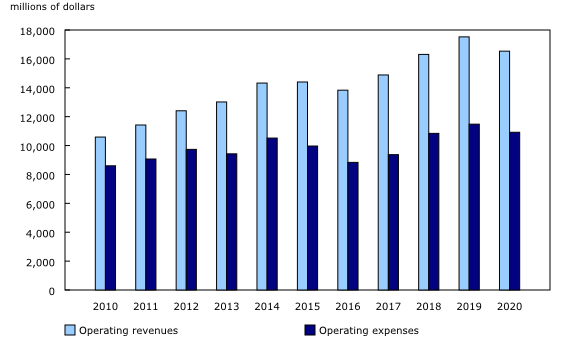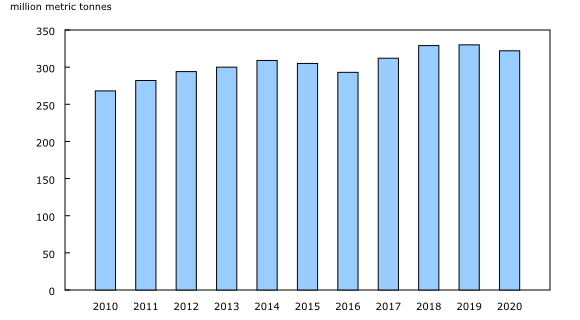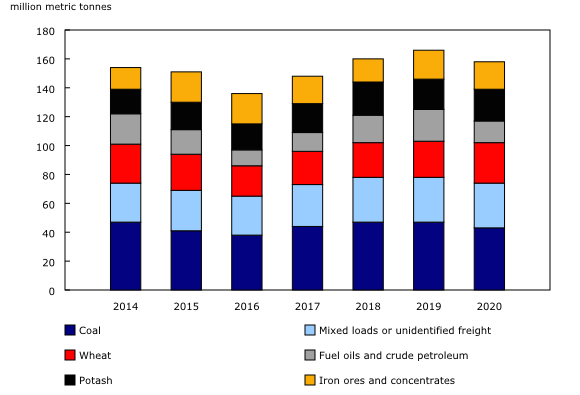Rail transportation, 2020
Archived Content
Information identified as archived is provided for reference, research or recordkeeping purposes. It is not subject to the Government of Canada Web Standards and has not been altered or updated since it was archived. Please "contact us" to request a format other than those available.
Released: 2022-04-08
In 2020, the impact of the COVID-19 pandemic helped to end three years of revenue growth, as Canadian railways posted operating revenues of $16.5 billion in 2020, down 5.6% from 2019. The Canadian rail transportation industry is comprised of two mainline freight carriers and several short line freight railways along with passenger rail companies.
Freight revenues drop
Freight revenues, which accounts for 90.0% of the industry's total operating revenues, declined 6.0% from 2019 to $14.8 billion in 2020. This decline was not as steep as that experienced by many other industries, such as airlines for examples, since railways are deemed an essential service in the context of the COVID-19 pandemic and continue to move commodities and critical goods.
However, short-line carriers took a harder hit during the pandemic than the mainline freight carriers, as short-line carriers often serve specific commodities or industries. These smaller carriers, which accounted for 2.6% of the total rail operating revenues, experienced a 42.3% drop in operating revenues.
Passenger rail severely hit as travel wanes
Ridership fell in 2020 due to Canada-wide restrictions on non-essential travel during the pandemic. Consequently, passenger revenues declined by 76.7% to about $97 million compared with 2019. While service reductions brought a sharp decrease in passenger revenues, other rail revenues and government payments (including pandemic support) increased 22.2% to $1.6 billion.
Some expenditures drop more
Railway operating expenses also decreased, down 4.9% from 2019 to $10.9 billion in 2020. However, among the expenses items, the decline was uneven. For instance, general administration costs, which include wages and salaries, sharply decreased by 16.5% to $2.1 billion, while rail operations decreased 9.9% to $4.3 billion.
In 2020, with less freight to haul and lower world oil prices, fuel expenditures by the railways sharply decreased from $1.9 billion in 2019 to $1.8 billion in 2020, down 4.2%. On the other hand, in 2020, equipment increased 13.1% to $2.2 billion, and maintenance of way increased 3.1% to $2.3 billion.
With overall expenditures declining at a similar rate as operating revenues, the industry operating ratio (operating expenses expressed as a proportion of operating revenue) was unchanged at 0.66, the same rate achieved in 2018 and 2019. In other words, railways incurred $66 of expenses to generate $100 in revenue.
Fewer employees as revenue tonne-kilometres decline
With the pandemic reducing some rail activity in 2020, the average number of railway employees dropped to 31,607, a decrease of 8.7% over 2019. This resulted in some savings, with the total annual wages and related benefits declining from $3.4 billion in 2019 to $3.0 billion (-11.0%) in 2020. Consequently, labour productivity—tonne-kilometres per railway employee—increased 2.0% to 13.3 million.
The decline in railway revenue along with a shorter average haul impacted revenue tonne-kilometres (revenue earned for transporting one tonne of freight over one kilometre). The total decreased by 6.9% from 451 billion tonne-kilometres in 2019 to 420 billion tonne-kilometres in 2020, the lowest annual level since 2017. In addition, the average number of cars per freight train rose to 120 cars, with average train speed unchanged at 37 kilometres per hour.
Impacts on freight volume minor
The February rail blockades in support of Wet'suwet'en First Nation followed by the first wave of pandemic lockdowns did not appear to significantly hamper rail freight. In fact, freight tonnage declined 2.6% from 2019 to 321.7 million tonnes, but there were discernible changes in the relative commodity weightings.
While the economy-wide lockdown in March 2020 slowed rail freight activity considerably in the second and third quarters, freight volumes started to recover in the fall and ended the year on a stronger note. Essential goods and commodities continued to be shipped by rail, mostly because of a global demand for farm and food products.
Despite this sharp increase in farm commodities moved by rail, there was sufficient capacity available with a lower demand for energy-related shipments. Consequently, the higher volume of agricultural and food products transported by rail moderated the impact of the pandemic on overall freight tonnage.
Pandemic shifts some key commodities
Of the overall rail tonnage in 2020, six commodities continued to contribute half of the entire freight volume, but with changes in the relative contribution. Within the top six commodities, wheat (+3.4 million tonnes) and potash (+1.8 million tonnes) experienced the largest year-over-year absolute increases.
Conversely, fuel oils and crude petroleum (-7.0 million tonnes) and coal (-3.5 million tonnes) showed the largest year-over-year declines, with travel restrictions persisting through the year and some industrial activity shuttering.
Western Canada continues to dominate
From all commodities that originated from a Canadian location, almost three-quarters (74.8%; 208.4 million tonnes) came from Western Canada (Alberta, Saskatchewan, British Columbia and Manitoba).
Loadings in the West increased for farm commodities including wheat, up 14.0% from 2019 to 27.5 million tonnes in 2020. Similarly, canola shipments increased 27.7% from 2019 to 12.9 million tonnes in 2020, while loadings of potash, a non-metallic mineral used in the production of fertilizer, were up 8.5% to 22.5 million tonnes in 2020.
However, shipments of energy products from the West sharply decreased due to weaker demand. Loadings of fuel oils and crude petroleum from the region declined by 33.3% from 2019 to 13.7 million tonnes in 2020. Although coal shipments declined by 7.3% to 33.8 million tonnes in 2020, it remained the leading commodity hauled by rail across the region.
Note to readers
This release is based on two data sources, an annual survey and a commodity origin and destination statistics administrative file from Transport Canada. The former collects financial as well as operating and employment data from a census of Canadian railways that provide for-hire freight and passenger services.
The commodity origin and destination statistics file measures the movements of commodities carried by Canadian National Railway (CN), Canadian Pacific Railway (CP), carriers that interline with CN and CP, as well as a number of short-line carriers that do not interline with either CN or CP.
Financial, operational and origin and destination data may change on a year-to-year basis as a result of fluctuations in currency exchange rates, reclassifications of accounts, etc. Data are also influenced by mergers, acquisitions and companies which may enter or exit the industry.
Data aggregations are available for Canada and select geographic regions.
It is important to note that the universe of short-line carriers changes regularly. In particular, in 2018, data from one company was added to the estimates for the first time. In previous years, this company was classified as inactive, and no estimates were made. Therefore, any comparison of 2018 data with that of previous years should be made with caution, since this constitutes a break in the series.
A short-line freight railway usually takes goods from one or more points to a point on the larger transportation network, which is usually a mainline railway, but may be a trans-shipment point onto another transportation mode. These are carriers with less than $250 million in annual revenues, for at least two years in a row.
Mainline freight railways usually move goods on the larger transportation network and are carriers with $250 million and more in annual revenues for at least two years in a row.
Products
The infographic "Rail transportation in Canada, 2020" is now available as part of the series Statistics Canada ― Infographics (11-627-M).
Contact information
For more information, or to enquire about the concepts, methods or data quality of this release, contact us (toll-free 1-800-263-1136; 514-283-8300; infostats@statcan.gc.ca) or Media Relations (statcan.mediahotline-ligneinfomedias.statcan@statcan.gc.ca).
- Date modified:





